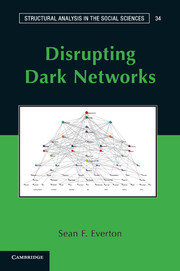Book contents
- Frontmatter
- Contents
- Figures
- Tables
- Preface
- Acknowledgments
- Part I Introduction
- Part II Social Network Analysis: Techniques
- 3 Getting Started with UCINET, NetDraw, Pajek, and ORA
- 4 Gathering, Recording, and Manipulating Social Networks
- Part III Social Network Analysis: Metrics
- Part IV Social Network Analysis: Advances
- Part V Conclusion
- Appendix 1 The Noordin Top Terrorist Network
- Appendix 2 Glossary of Terms
- Appendix 3 Multidimensional Scaling with UCINET
- Appendix 4 The Just War Tradition
- References
- Index
3 - Getting Started with UCINET, NetDraw, Pajek, and ORA
Published online by Cambridge University Press: 05 April 2013
- Frontmatter
- Contents
- Figures
- Tables
- Preface
- Acknowledgments
- Part I Introduction
- Part II Social Network Analysis: Techniques
- 3 Getting Started with UCINET, NetDraw, Pajek, and ORA
- 4 Gathering, Recording, and Manipulating Social Networks
- Part III Social Network Analysis: Metrics
- Part IV Social Network Analysis: Advances
- Part V Conclusion
- Appendix 1 The Noordin Top Terrorist Network
- Appendix 2 Glossary of Terms
- Appendix 3 Multidimensional Scaling with UCINET
- Appendix 4 The Just War Tradition
- References
- Index
Summary
Introduction
The advent of the personal computer has played a large role in the growth of social network analysis (SNA). Indeed, it is unlikely that SNA could have developed like it has without it (Freeman 2004:139–141; Wolfe 1978) because SNA relies on complex mathematical and graphical algorithms (Freeman 2004:3, 135–136). Over the years, a number of SNA software packages have been developed, all of which have their own strengths and weaknesses – see Huismanand van Duijn(2011) for a comprehensive review of the available packages. In this book we focus on UCINET (along with its integrated visualization program, NetDraw), Pajek, and ORA, not because they are necessarily the best programs (although they are quite good), but because they are readily available, widely used, and relatively inexpensive (all but UCINET are free). Indeed, in Huisman and van Duijn's (2011:585–590) review of general stand-alone SNA software packages, these three were among the five packages that were discussed at length. Moreover, users who gain a familiarity with the logic and features of these programs should be able to migrate to other SNA packages with relative ease. This chapter provides a basic introduction to these programs – their interfaces, features, visualization capabilities, strengths, weaknesses, and so on – whereas Chapter 4 discusses the collection, recording, and manipulation of network data.
UCINET
UCINET was initially developed by Linton Freemanat the University of California, Irvine (hence, the “UCI” in “UCINET”), and was later refined by others, in particular, Steve Borgattiand Martin Everett(Scott 2000:178–179). It is the best-known and most widely used social network software, primarily because it has been around for a long time and it contains a large number of SNA metrics and data management tools (Huisman and van Duijn 2005:275–280, 2011:585–586). Not only does it implement most of the routines needed for estimating measures of network topography (e.g., density, centralization, fragmentation), calculating actor centrality (e.g., degree, betweenness, closeness, eigenvector), identifying subgroups (e.g., cliques, components, factions, Newman groups), and estimating various measures of structural equivalence (e.g., structural, automorphic, regular), but it also includes tools for selecting subsets of files, merging and stacking datasets, transposing and/or recoding data, and importing and exporting of data in a variety of formats (Huisman and van Duijn 2005, 2011). UCINET is menu driven. Its commands call up dialog boxes that specify the inputs needed for it to run its various routines; results are displayed using Window's Notepad program and subsequently saved in log files.
Information
- Type
- Chapter
- Information
- Disrupting Dark Networks , pp. 49 - 75Publisher: Cambridge University PressPrint publication year: 2012
